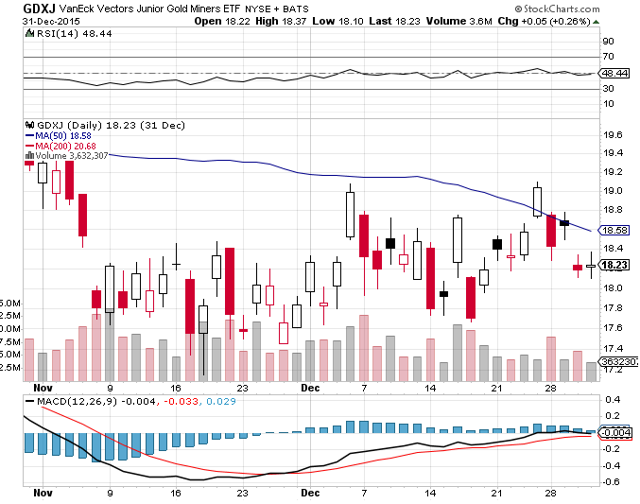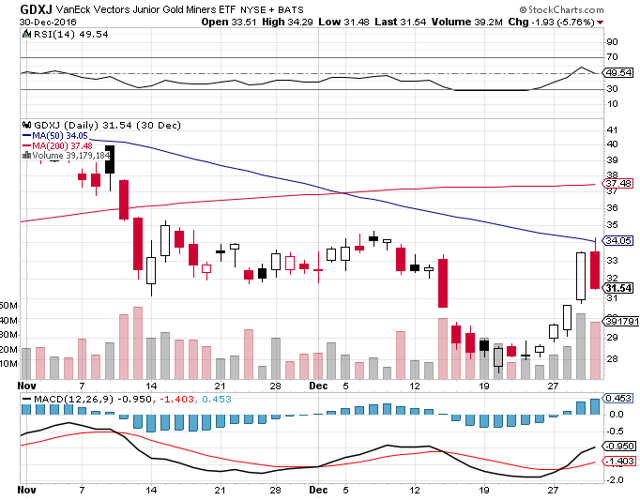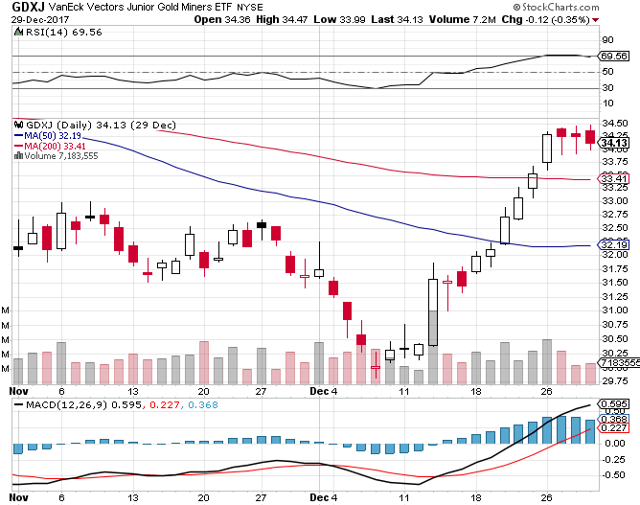History: Year-End Gold Bottom And Rally Can Happen In November As Well As December
With gold and miners selling off Friday on fears of Fed rate hikes and year-end tax loss selling, many investors fear the decline will continue through December.
But recent history shows us the gold and miners market is not so simple at the end of the year:
The bottom can and has arrived in mid-November or the first of December, as likely as later in December.
When it does, the sudden immediate rally off the bottom often delivers some of the biggest gains in the gold miner sector.
Now is the time to be buying gold miner stocks, not selling them.
With gold (GLD) (PHYS) and gold miners (GDX) (GDXJ) selling off Friday on fears of Fed rate hikes and year-end tax loss selling, many investors now fear that the decline will continue through December.
I think the negativity and fear that has swept through the sector this week is exaggerated and short-sighted.
Of course some disappointment is only natural, coming after the impressive strength that gold showed as a safe haven asset in October during the stock market selloff.
But too many people in the sector seem to be writing off gold and gold miners for the rest of the year already, based on the negative momentum and seasonality patterns that seem to have become gospel to gold investors in recent years.
In fact, a careful study and examination of recent history will show us that these supposed year-end patterns are not so simple and straightforward as many people now believe.
The bottom in gold and gold miners can and has arrived in mid-November or the first of December, as likely as later in December. When it does, the sudden immediate rally off the bottom often delivers some of the biggest gains in the gold miner sector. In this scenario, you will be rewarded very nicely if you buy gold miners right now, and you will regret it if you panic and sell gold miners in the current selloff.
The Year-End Fundamentals of Gold and Gold Miners
I want to begin, as always, with the fundamentals, before I get to the technical and seasonal picture to take a look at those details.
Foremost on everyone's minds right now is the Fed and interest rate hikes. Yes, the Fed will hike rates again in mid-December. This is a foregone conclusion, everyone knows it, and all markets have completely priced it in already. The more important question is what the Fed will or will not do next year: investors and traders are carefully reading and listening to every Fed statement for clues about hawkish or dovish guidance about their plans for 2019.
The fact is that the Fed rate hikes have ALREADY done severe damage to the global economy in 2018. The Fed may claim that their only mandates are to limit US inflation and support US employment, but the actual reality is different in the world we live in. The Fed may not claim to care about the global economy, but the global economy cares about the actions of the Fed.
Interest Rates Today Are Artificial Central Bank Creations
The fact is that the rest of the world is still dependent on Zero Interest Rate Policy, or very close to it. Just take a look at the latest 10-Year government bond yields for the US, Germany, Japan, the UK, and France:
The yield an investor receives is supposed to be based on the risk that he takes: the lower the risk, the lower the yield should be; the higher the risk, the higher the yield should be.
And yet, as you see above, the US Treasury bond yield is 2.4% greater than the French government bond yield, of all places. In fact, due to the Fed rate hikes, even a 1-month US Treasury bond now yields 2.21%. Does anybody in the world seriously believe that loaning your money to the French government for 10 years is less than half as risky as loaning your money to the US government for 1 month? No. It is absurd.
This shows that interest rates and bond yields today are entirely artificial creations of the world's central banks. The French bond yield is low, not because it is safe, but because the European Central Bank buys and owns trillions of euros worth of them to keep the yield down.
The point and the bottom line is simple:
In a world where Japan's 10-year yield is 0.12%, Germany's is 0.41%, and France's is 0.79%, the Fed cannot hike US interest rates up to 2%, 3%, and beyond, without distorting and crashing the global economy.
This distortion, caused by the Fed rate hikes, has already pushed global currency markets to the breaking point. The rate discrepancy has artificially strengthened the US dollar and weakened most other global currencies. This is extremely damaging to economies everywhere, and especially to emerging-market economies, where US dollar debt becomes an unbearable burden. The disastrous currency crashes in Turkey and Argentina, and the sharp currency declines in India and elsewhere, highlight the dangers of an artificially strong US dollar to the global economy.
If the Fed keeps hiking rates in 2019 and damages the global economy even more, that will be bullish for gold as a safe haven asset, including as protection from currency crashes for everyone outside the US.
If the Fed pauses or stops the rate hikes in 2019, that will be bullish for gold based on lower real interest rates and higher inflation.
The Year-End Tax Loss Selling Argument
It is widely believed that gold miner stocks also sell off near the end of the year due to investors doing a lot of tax loss selling. The gold market has been so bearish for so long, that gold sector analysts almost take this phenomenon for granted, assuming that gold miner shareholders are always sitting on losses every year, so they sell shares for the tax deductions.
To be sure, on an individual basis, many investors who own gold mining stocks surely do some of this tax loss selling near the end of the year. But I question how significant or dominant an influence this action has on the market as a whole.
Given how unpopular and out of favor the gold miner sector has become over the past 7 years, are there really enough shareholders left at all, for their tax loss selling this year to really move the market? Didn't they already sell at the end of 2011, and 2012, and 2013, and 2014, and 2015, and 2016, and 2017? Moreover, we just had a very sharp gold miners selloff as recently as this August. At a certain point, the selling pressure is simply exhausted, and almost everybody who wanted to sell, has already sold.
Recent History: Bottoms in November and the First of December
I often hear the common belief that one should wait until late December to buy gold miner stocks, to let the Fed get its rate hike out of the way in mid-December, and to wait until most of the supposed year-end tax loss selling is done. The idea is that people think gold miner stocks will be cheaper in late December, than they are in November or early December.
But is this really the case most of the time? Actually, even as recently as 2 of the past 3 years, it is not.
Here is the price chart of GDXJ in late 2015, the famous bottoming period, when those of us who jumped into junior gold miner stocks made enormously huge gains in 2016. Here is that chart in November and December 2015:
As you can see, junior gold miners actually reached their low point of late 2015 on November 17 and 18, NOT in December at the time of the first Fed rate hike.
In 2016, on the other hand, junior gold miners did bottom after the Fed rate hike in mid-December, and then rallied in the last week of December:
And in 2017, junior gold miners bottomed in the first week of December, then started a sudden and strong rally before, during, and after the Fed rate hike in mid-December:
So as we see, the actual bottoming patterns had completely different timing near year-end in the last 3 years. The same dynamics of a Fed rate hike and tax-loss selling were present each year, but the junior gold miners market timed the bottom very differently in each case.
My point is, there is no way to know whether the absolute lowest bottom will be in mid-December, in early December, in mid-November, or even this past Friday, November 9. We just don't know.
I see the current period as an opportunity to accumulate more shares of select junior gold miner stocks when they are hated and cheap. The exact bottom may come at any time, but if you buy steadily, that timing won't matter so much. What will matter is that 3 to 6 months from now, those who bought gold miners at any time in November and December will likely make some very significant gains.
My subscription service, the Stock & Gold Market Report, offers:
Complete model portfolioTop 10 junior gold miner stock picks2 top platinum miner stock picks#1 top silver miner stock pickMassive potential gains for 2018 and 2019Value beyond the initial stock picks - valuable guidance about:
When to take profits, when to sellWhen to let winners rideWhen to cut lossesWhen to hold through volatilityWeekly portfolio updates and commentary on global financial marketsFocus on the precious metals & miners marketCheck it out and subscribe today!
Disclosure: I am/we are long PHYS.
I wrote this article myself, and it expresses my own opinions. I am not receiving compensation for it (other than from Seeking Alpha). I have no business relationship with any company whose stock is mentioned in this article.
Additional disclosure: I am long many junior gold miner stocks. Further details are available to subscribers of the Stock & Gold Market Report.
Follow Geoffrey Caveney and get email alerts


